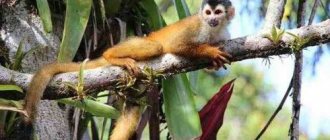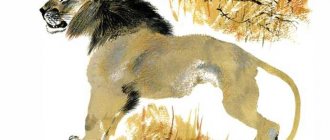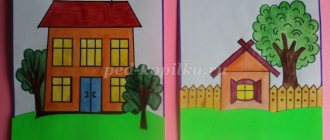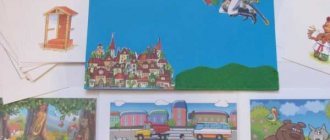Quiz game “Animals of hot countries”
Evgenia Yuktesheva
Quiz game “Animals of hot countries”
Quiz game on the theme “ Animals of hot countries ”
.
Goal: Creating a social situation for the development of children through cognitive and play activities.
Tasks:1. Create conditions for generalizing children's knowledge about animals of hot countries and northern countries .
2 Create conditions for enriching and activating the vocabulary in the names of animals , the features of their residence.
3. Create conditions for the development of logic, thinking, attention, coherent and dialogical speech.
4. Create conditions for developing the ability to work in a team and a friendly attitude towards peers
Conversation about animals , looking at illustrations , photographs, classes according to the plan of educational activities, reading fairy tales, stories on the topic, asking riddles, looking at presentations, making fakes, active, didactic games on the topic.
Quiz with answers for preschoolers 6-7 years old. Wild animals of hot countries
Quiz “Wild animals of hot countries” for children of the preparatory group of a preschool educational institution
Author: Kovalchuk Valentina Nikolaevna, teacher of kindergarten No. 90 in the city of Tyumen. Description: Final lesson on the topic “Wild Animals of Hot Countries” from my practice in the senior group. This material will be useful to teachers of senior and preparatory groups of kindergarten. Goal: Generalization of knowledge on the topic “Animals of hot countries.” Objectives: 1. To consolidate children’s knowledge about wild animals of hot countries: their appearance, habits, behavioral characteristics. 2. Activate the vocabulary on the topic “Wild animals of hot countries.” To develop the ability to write stories about wild animals of hot countries. 3. Develop the ability to read poetry expressively, with natural intonations, and participate in the reading of text in poetic form by role. 4. Foster a respectful, caring attitude towards wild animals. Demonstration material: 1. Pictures with images of animals from hot countries. 2. Figures of animals from hot countries. 3. Exhibition of drawings and sculptures from plasticine on the topic “Wild Animals of Hot Countries” (for classes I used the book by G. Shalaeva “Learning to Draw” and the book by R. Oren “Secrets of Plasticine”) Preparatory work: 1. The teacher individually gives children riddles about wild animals of hot countries for learning.
2. Children learn a lot about wild animals of hot countries and talk about them themselves. 3. Children sculpt and draw wild animals of hot countries. 4. Reading “Telephone” by K. Chukovsky, excerpts from which are told by role. Progress of the lesson:
Educator:
Today we will conduct our lesson in the form of a game - a quiz. Topic: “Wild animals of hot countries.” We will divide into 2 teams: “Znayki” and “Pochemuchki”.
Competition No. 1
“Writer” Educator:
You are invited to portray a famous writer who came up with a story about an animal or bird of hot countries.
Team “Knowledge” begins. (The children learned this during two weeks of work on this topic and used it in their story.) A lion is a strong, beautiful and dexterous animal, similar to a big cat. The lion has a mane. A lioness does not have a mane. The animal's fur is yellow, short and smooth. At the end of the tail there is a tuft of hair. The lion's legs are very strong, with wide paws; the claws are sharp, like those of a cat, and the habits of a lion are feline. The lion sleeps during the day and goes hunting in the evening; It always lies in wait for its prey, unexpectedly rushes at it, strikes it with its powerful paw, tears it with its claws and sharp teeth. It also attacks livestock. Leo is a predator. Lions live in the steppes and deserts of Africa and South Asia. Due to its yellowish color, the lion is hardly noticeable among stones and sand. A lioness gives birth to 2-3 cubs - lion cubs, similar to large kittens. Giraffes are the tallest living creatures on earth. Their height can exceed 6 meters. They have long legs and a long neck, and a small head, topped with 2 (3-5 rarely) horns, sways importantly on the neck. The head is decorated with kind brown eyes and mobile narrow ears. The coat is short, with dark spots of bizarre shape scattered across a light yellow background. A short brown mane grows on the neck. The legs have hooves. At the end of the tail there is a tuft of hair. Giraffes feed only on tree leaves and young branches. Giraffes eat low-growing trees from above. They have a long tongue, up to half a meter, and tenacious lips. Favorite food is acacia. They, like experienced gardeners, trim the tree crowns. Wild giraffes live in Africa, where there are plenty of trees. A newborn giraffe is about 2 meters tall, that is, the height of a tall adult. Giraffes sleep standing up. They cannot run fast or much because of their small lungs, 2 times smaller than a horse’s lungs. Kangaroos are animals that live only in Australia. Their height reaches the height of a tall person. Animals move by jumping and at high speed. Kangaroos can jump over the heads of people standing at full height. They have long hind limb feet. The kangaroo moves on them. When males fight, they grab each other with their front paws and, leaning on their tail, hit the enemy with their hind paws. A kangaroo has a pocket on its belly. This is a marsupial. There is a baby kangaroo sitting in a pouch on the female’s belly. They feed on leaves. In the circus or in the zoo you can see a medium-sized kangaroo - a wallaby. The hippopotamus spends its entire life in water and leaves the pond to eat or sunbathe. His huge body, which would fit a monstrous pig, rests on the short legs of a pedestal. The body of hippopotamuses reaches 4 meters in length and 1.5 meters in height. The huge head is decorated with small ears and eyes, which are most often very kind. Dark brown thick skin is naked, short tail. Hippos start eating after sunset. They eat any grass. To get enough, hippos need 50 kg of grass. A hippo's baby is born underwater weighing 40-50 kg. To take a sip of milk, he must dive and find his mother's nipples. Now hippopotamuses are preserved only in Africa. The tiger is the largest of all cats on Earth. Its long body is covered with red fur with black stripes and it is invisible among the reeds and forests. The tiger has small ears and long whiskers. Legs with large strong paws. They have long sharp claws. Like a cat, a tiger cleans its fur and face with its paw and tongue, arching its back and playing with its tail. The tiger hunts deer, wild pigs, attacks domestic animals and rarely humans. Like a cat and a lion, a tiger quietly creeps up to its prey, hides and suddenly jumps on it. Catches prey with its front paws. When the tiger is hungry, he eats frogs and lizards, and even berries. Almost half of the tigers live in India, in our country - in the Far East. The elephant is the largest proboscis animal on land. Its gray thick skin is bare, only at the tip of its tail there is a tuft of hair. The short, massive body rests on thick, pillar-like legs with 5 toes each. The neck is very short and clumsy. Large ears hang on the head. Small eyes set deep. The nose, fused with the upper lip, is extended into a long trunk, at the end of which there are nostrils and a finger-like outgrowth that acts as an organ of touch. The trunk is very mobile. An elephant can lift large and small objects from the ground, tear off branches and bring them to its mouth, and tear out trees. Two tusks protrude from the elephant’s mouth, with which the elephant clears its way in the forest, defends itself from enemies, and digs up the roots of plants. Elephants have 24 molars in their jaws, but only 4 are active at a time, the rest are hidden.
People catch and tame elephants, force them to carry weights, and ride them. Elephants' food is grass, branches, leaves, roots, fruits. An adult elephant eats 180 kg of greens and drinks about 100 liters of water. Elephants, breaking off branches, seriously damage the forest. Elephants are found in the forests of Africa and Southeast Asia. Elephants give birth to one calf and for 3-5 years the elephant feeds it with her milk. A baby elephant grows up at 8-12 years of age. Monkeys are the smallest and most primitive monkeys. Weight up to 10 kg. The body structure of the monkey is adapted to life in the trees. Both pairs of limbs are similar to human hands: the fingers are covered not with claws, but with nails; palms and soles are free of hair. When climbing trees, they use all four limbs like hands; They walk on the ground on all fours. Monkeys deftly jump from branch to branch. Swing on them. Monkeys feed on buds and juicy fruits of trees, and in summer on bird eggs. In some places they raid gardens and vegetable gardens. Monkeys live in herds in the forests of Asia and Africa. Marmosets are often kept in captivity. They are very sociable and imitate people's actions. The female takes great care of her cubs, feeds them milk, and then brings them insects, berries, and bird eggs. (One of the children comes out to applause and tells his story, showing a picture of an animal).
Competition No. 2
“Riddles and Guessings” Educator:
First, the “WhyCheks” team makes its riddle to the “Knowledgers,” and then the “Knowledgers” make a riddle to the “Whychechens.”
Walks softly along the paths, Looks like a big cat, Flexible, mustachioed, Striped fur. Even though he looks like a cat - You won’t approach him: There is great strength in his paws - He can overwhelm a bull, There’s no time to play with this beast, He’s very dangerous... (tiger) (S. Vasilyeva, V. Miryasova) Looking into the mirror at dawn, He was pleased with himself: Intimidatingly handsome, Graceful, yellow-maned, Paws strong and powerful, Roar rushing above the clouds. In hot Africa. (Lion) (V. Miryasova) Long neck and long legs, This animal walks in anxiety, Pinches leaves. Noticeable to the enemy, He is afraid of being caught by a tiger and a lion. Oh, why is he so handsome, If he is so timid and so fearful? (Giraffe) (V. Miryasova) I am green, blue - This is my favorite color. And he was spinning around the mirror, and even fell off the twig. I pecked at the millet a little, and suddenly from the cage I saw a cat. I told her in the voice of a housewife: “Do you want to eat, beggar?” The cat looks and doesn’t understand, Who is calling her to eat? (Parrot) (V. Miryasova) Thin neck, long legs, A strange bird runs along the road, flaps its wings, cannot take off, But a person cannot keep up with it. The run of that bird is very fast - No, a person will not catch up with it. And there’s no need, because she might kick. She doesn’t like it when people block her path. These birds nest right in the grass, green eggs are stored in the nests, male fathers sit in bird nests, guard the chicks, do not drink or eat. There is no larger bird in the world than this one. Who is this bird? Come up with an answer. (Ostrich) (S. Vasilyeva) The tusks turn white, like snow, The animal is the strongest. Huge, gray, with a good disposition, he walks majestically through the jungle, and with his long nose, like a hand, he can lift you and me. (Elephant) (V. Miryasova) Someone carries matches in a bag, Someone carries important things, Someone carries a book and a game, And the kids ... (kangaroo). She is hidden like a mask, Protective coloring from everyone, Marked like a passage, She walks through Africa. (Zebra) This handsome man is familiar to everyone with his magnificent plumage, He is rightfully proud of his decoration - The colors of the rainbow and his shining tail. (Peacock) (S. Vasilyeva) Its beak has a big bag, It catches fish like a net. (pelican) came to the zoo from distant countries . (S. Vasilyeva) He is not an old man - but a hunchback, Not a sheep - but a treasure trove of wool, And strong and patient, And not whimsical in food, He likes deserts, He lives where melons ripen. (Camel) (V. Miryasova) There are a lot of needles - but not a hedgehog, Even though he looks like a hedgehog. Its spines are longer, its white needles are sharper. He raises them high - This is how this beast scares his enemies. The beast is prickly and formidable outside, It eats fruits and leaves for dinner. He only lives in hot countries, and is waiting for us to visit the zoo. (Porcupine) (S. Vasilyeva) I can jump through trees no worse than a cat And in our ancient jungles I don’t need paths. Green vines will replace my swing, If only my favorite bananas ripen. (Monkey) (V. Miryasova) There are quite a few horned animals In the zoo and in the forest They all have horns on their heads, Only one has horns on their nose. (Rhinoceros) (S. Vasilyeva) Thick-skinned, thick-lipped, And there are four teeth in the mouth. If he opens his mouth, you might faint! (Hippopotamus) (S. Vasilyeva)
Outdoor game “Crocodile”
The driver in the role of a “crocodile” depicts a toothy mouth, stretching his arms forward one above the other. The “crocodile” dances to cheerful music, plays with the children, and then unexpectedly closes his hands. Whoever gets caught is the driver. The game is repeated several times.
Competition No. 3
“Theater ” Educator:
Both teams prepared role-play readings of excerpts from K. Chukovsky’s poem “Telephone” (using masks and telephones). 1. — My phone rang. - Who's talking? - Elephant. - Where? - From a camel. - What do you need? - Chocolate. - For whom? - For my son. - How much should I send? - Yes, about five pounds. Or six: He can’t eat anymore, he’s still small! 2. And then the Crocodile called and asked with tears: - My dear, good one, Send me galoshes, And for me, and for my wife, and for Totosha. - Wait, didn’t I send you two pairs of excellent galoshes last week? - Oh, those that you sent last week, We ate them a long time ago and we can’t wait for you to send a dozen new and sweet galoshes for our dinner again!
Competition No. 4
“Predators and Herbivores” Educator:
It is necessary to divide the animal figures into 2 groups: “herbivores” and “predators”. The “Why Chek” team chooses “herbivores”, and the “Knowledge” team chooses “predators”. Herbivores: kangaroo, camel, rhinoceros, zebra, hippopotamus, giraffe, porcupine, elephant, parrot, monkey, ostrich. Predatory animals: lion, tiger, pelican, peacock.
Musical pause.
All children dance to the song “Chunga - Changa” (Words by Yu. Entin, music by V. Shainsky).
Competition No. 5
“Questions and Answers” Educator:
I will ask questions about wild animals of hot countries, and you try to answer them. Whoever knows the answer raises his hand. 1. Name the representatives of the cat family living in hot countries. Answer: Lion, tiger, leopard, ocelot, cheetah. 2. Which animal is the fastest on earth? Answer: Leopard. 3. Which animals of hot countries have a long tail that serves as their fifth arm, and they can hang on it? Answer: Monkeys. 4. Which animal in hot countries has needles attached to a special muscle and is easily separated from it? It plunges needles into the enemy's body with such force, as if they were arrows fired from a bow. Answer: Porcupine. 5. The height of these animals sometimes reaches the height of a human; they are bipedal, like birds, move in leaps, like frogs or grasshoppers, and do they have a head like a deer? Who is this? Answer: Kangaroo. 6. Which animal has the largest egg in the world? Answer: An ostrich. 7. Which bird is the largest on earth? Answer: Ostrich. Only she doesn't fly. 8. What parrots do you know? What are the advantages of each of them? Answer: Cockatoo (with a tuft), Gray (famous talker), Macaw (very bright feathers), lovebirds (if one dies, the second will die of melancholy). 9. How many cubs does an elephant have? Answer: One. 10. Which bird eats only fish and first collects it in a bag under its beak? Answer: Pelican. 11. What is giraffe's favorite food? Answer: Acacia. 12. What animals of hot countries are mentioned in K. Chukovsky’s poem “Telephone”? Answer: Elephant, camel, crocodile, monkeys, kangaroo, rhinoceros, hippopotamus. 13. A camel can live without water for about 6 weeks. But at the first opportunity he will drink 5 or even 9 large buckets of water in one gulp. Where does a camel store its stored moisture? Answer: A camel’s humps contain about 100 kg of fat, which serves as food and drink on the way. It’s not for nothing that after long treks, both humps of a camel become so thin that they even hang over their sides like empty sacks. 14. Which animals have feet protected by calloused pads that are as elastic as rubber? Answer: A camel. There are calluses on the knees and other parts of the camel’s body that come into contact with the hot soil when it lies down. 15. We believe that zebras are white and have black stripes, but Africans believe that zebras are black and have white stripes. Who is right? Answer: Both. It must be said that zebras recognize each other by the pattern of their stripes, and each zebra has its own pattern. 16. What is the main attraction of rhinoceroses? Answer: Indians have one horn, and Africans have two. 17. After elephants, which animal is the largest on Earth? Answer: Rhinoceros. 18. What animal in hot countries spends half its life in water? The length of some of them reaches 16 meters. An animal's body temperature depends on the ambient temperature. Answer: Crocodile. 19. Which animal has a huge body that rests on the short legs of a pedestal? He spends almost his entire life in the water and leaves the pond only to have breakfast or sunbathe. Answer: Hippopotamus. 20. Let us remember “Aibolit” by K. Chukovsky: “You have a telegram from a hippopotamus!” Who is a “hippopotamus”? Answer: Hippopotamus.
Results of the competition
Educator:
Our quiz is over. Both teams showed good knowledge of wild animals of hot countries. Well done!
We recommend watching:
Quiz with answers on fairy tales for children of the preparatory group Game quiz on fairy tales for preschoolers 6-7 years old Intellectual quiz “What? Where? When?" for preschoolers of the preparatory group Quiz for preschoolers of the senior preparatory group. Dymkovo toy
Similar articles:
Quiz on the topic “Trees and shrubs” for children 5-7 years old
Quiz on the topic “Wild Animals” for children 5-7 years old
Quiz on the theme “Birds” for children 6-7 years old
Quiz with answers “Andersen's Fairy Tales” for preschoolers
Quiz with answers “Fairy Tales of Charles Perrault” for preschoolers
Didactic game “Animal world of hot countries”
Ulyana Beletskaya
Didactic game “Animal world of hot countries”
Didactic game
"FAMILY OF HOT COUNTRIES"
Explanatory note:
The fauna of hot countries is very diverse and attractive to children. I noticed children’s interest in animals: children bring figurines of different animals from home and try to draw them, sculpt them from plasticine, in particular, a turtle, giraffe, crocodile, lion, camel, panda; share their impressions of the educational programs they have seen, and pay attention to illustrations from the group’s books about animals. Particular interest in animals during the educational activity “Acquaintance with the world around us.” This is how the idea of an in-depth study of the topic “Animals of Hot Countries” and creating a model for a didactic game emerged.
Goal : expand children's knowledge about animals of hot countries.
Tasks:
To form children’s ideas about the natural areas of the Earth
Introduce children to wild animals: deserts, savannas, jungles. Their way of life, habits, adaptability to their environment.
First version of the game
Goal: development, stimulation of attention, learning to quickly and accurately respond to sound signals.
Outdoor games for preschoolers on the topic: Animals
Outdoor and speech games for preschoolers on the topic: “Animal world”
The Federal State Educational Standard provides for ensuring a variety of organizational forms of preschool education, which take into account the educational needs, abilities and health status of children.
A variety of forms of children's activities in preschool educational institutions is also used during walks. Children strive for active activity, and it is important not to let this desire fade away and to promote its further development. The closest and most natural type of activity for children is play. Children develop motor skills and abilities, strengthen the muscular system, and increase vitality. The proposed material is intended for educators, parents and primary school teachers. Outdoor game “At the Bear in the Forest” Goal:
to develop children’s motor activity skills, combining them with cognitive, research, communicative activities, taking into account the safety of children’s lives;
develop courage, dexterity, speed of action. Progress of the game:
A bear child sits on a stump, children in a flock move along the territory of the site past the bear;
imitating picking berries, pronounce the words: The bear has mushrooms in the forest, I take berries. But the bear does not sleep and growls at us... The bear makes a “roar” and catches up with the children; Whoever catches up with him leaves the game. Outdoor game “Sly Fox” Purpose:
to form children’s motor activity skills, combining them with cognitive, research, communicative activities, taking into account the safety of children’s lives;
practice running, develop agility and attention. How to play:
Children stand in a circle.
The teacher informs the children that he will discreetly touch any child while pronouncing the words for the game: “Sly fox, where are you? Sly fox where are you? Sly fox where are you? The child, touched by the teacher, voices: “I’m here!”, the children run into the scattering, the fox catches up with them. Outdoor game “Mice dance in a round dance” Purpose:
to form children’s motor activity skills, combining them with cognitive, research, communicative activities, taking into account the safety of children’s lives.
Progress of the game:
Choose a “cat” driver.
The cat chooses a “stove” (a bench or chair), sits on it and closes its eyes. All the other mouse participants join hands and begin to dance around the cat with the words: The mice are dancing, and the cat is dozing on the stove. Quiet the mouse, don't make noise, don't wake up Vaska the cat. When Vaska the cat wakes up, he will break up our round dance. While pronouncing the last words, the cat stretches, opens his eyes and begins to chase mice. The caught participant becomes a cat, and the game starts over. Outdoor game “The sea is agitated” Purpose:
to form children’s motor activity skills, combining them with cognitive, research, communicative activities, taking into account the safety of children’s life;
perform imitation movements, demonstrating beauty, expressiveness, grace, and plasticity of movements. How to play:
Children stand in a circle.
A leader is selected and stands in the center. Everyone pronounces words and moves freely, trying to create an unusual figure: “The sea worries once, the sea worries two, the sea worries three, the sea figure freezes in place,” at the end everyone freezes, the leader chooses the best figure, he becomes the leader. Outdoor game “Owl” Goal:
to develop children’s motor activity skills, combining them with cognitive, research, communicative activities, taking into account the safety of children’s life;
develop attention and reaction. Progress of the game:
The child “owl” sits on a bench, the children move around the territory with the words: Owl-owl, big head.
He sits on a branch, looking in all directions. Yes, how it will fly... The owl makes a sound “oof-oof” and catches up with the children. Outdoor game “Hunters and Animals” Goal:
to develop motor activity skills in children, combining them with cognitive, research, and communicative activities, taking into account the life safety of children;
develop accuracy and dexterity. Progress of the game:
“Hunters” are selected from their number of children, the rest are reincarnated as “animals”.
At a signal, the animals run, and the hunters catch them or throw a ball at them; who are hit or touched, they leave the game. Outdoor game “Mousetrap” Purpose:
to develop children’s motor activity skills.
Progress of the game:
Some children walk in a circle, holding hands - this is a mousetrap, pronounce the words: Oh, how tired the mice are, they gnawed everything, ate everything.
Beware, cheats, we will get to you. Once we set up a mousetrap, we’ll catch everyone at once! At this time, other children run through the circle, at the end of the last phrase, the children depicting a mousetrap crouch down and do not release the mice, and then they leave the game. The game continues until the last mouse is caught. Outdoor game “Geese-swans” Purpose:
to form children’s motor activity skills, combining them with cognitive, research, communicative activities, taking into account the safety of children’s lives;
develop attention and courage. Progress of the game:
On one side of the playground there are children - “geese”, on a bench sits a child who plays the role of a wolf, on the opposite side stands the “mother” - Goose, she calls the geese.
Geese, geese! Ha, ha, ha. Do you want to eat? Yes Yes Yes! Well, fly! We can’t, the gray wolf under the mountain won’t let us go home, he sharpens his teeth, he wants to eat us! Well, fly as you want, just take care of your wings! The geese flap their wings and fly towards the Goose. The wolf emerges from the ambush and catches the children who were left behind. Outdoor game “Birds of Migratory” Goal:
to develop children’s motor activity skills.
Progress of the game:
Presenter: We have one game, you will like it.
Children: The birds are still flying south, they want to spend the winter. Where there is sun and warmth, it will be easy to wait for spring. Only the wind interferes with them and knocks them off the road. According to the counting, the “breeze” is selected. Children stand on one side of the playground, read a recitative, at the end of the words, the children run to the opposite side - “warm countries”; the breeze catches them and leads them astray. Whoever is stained misses one game. Outdoor game “Sparrows and a dog” Purpose:
to consolidate children’s knowledge about the characteristic movements of birds, to teach them to imitate their voices.
Progress of the game:
The sparrow is jumping and jumping (children are jumping).
Jump-jump! Jump-jump! Calls small children: Chiv! Chiv! Chiv! Chiv! Chiv! Chiv! (repeat) Throw some crumbs to the sparrow, I’ll sing you a song: Chick-chirp! Tick-tweet! Suddenly a “dog” came running and barked loudly. The "sparrows" fly away. Outdoor game “Kite and Mother Hen” Purpose:
to develop motor activity skills in children.
Progress of the game:
One of the players is chosen as a “kite”, the other as a “hen”.
The rest of the children are “chickens”; they stand behind the hen, holding on to each other. On the opposite side of the site a circle is outlined - “kite’s nest”. At the adult’s signal “Kite!” a child kite flies out of the nest and tries to catch the chicken standing last in the column. The hen spreads her wings (extends her arms to the sides), protects her chickens and does not allow the kite to grab the chicken. All the chicks follow the movements of the kite and follow the hen, without looking away from each other, trying to prevent the kite from catching the last one. Outdoor game “Hares and the Wolf” Purpose:
to form children’s motor activity skills, combining them with cognitive, research, communicative activities, taking into account the safety of children’s life;
exercise in running; develop attention and courage. Progress of the game:
The “wolf” child sits in his “den”, the “hares” children jump on the lawn at a signal, imitating that they are eating grass and pronounce the words: Hares are jumping - hop, hop, hop, onto the green meadow.
They look for grass, listen to see if a wolf is coming. A “roar” is heard, everyone runs away into their holes (drawn on the ground); Whoever the wolf touches leaves the game. Outdoor game “Catch, fish, big and small” Purpose:
to form children’s motor activity skills, combining them with cognitive, research, communicative activities, taking into account the safety of children’s lives;
develop dexterity, attention, speed of reaction. How to play:
The fish children are located in a circle.
In the center there is a fisherman-educator who holds a rope, at the end of which a small bag of sand (jump rope) is tied. The fisherman rotates the rope in a circle just above the ground. The fish children jump in such a way that the rope does not touch their legs. Those participants whose legs were touched by the rope are eliminated from the game. Outdoor game “We are funny guys” Goal:
to form children’s motor activity skills, combining them with cognitive, research, communicative activities, taking into account the safety of children’s life;
develop dexterity, courage, attention. Progress of the game:
Children stand in a circle, choose a leader;
say the words: We, cheerful guys, love to run and play. Well, try to catch up with us - one, two, three, catch it! At the end of the words, everyone scatters around the site. Whoever the driver touches is eliminated from the game. Outdoor game “Burners” Goal:
to develop children’s motor activity skills, combining them with cognitive, research, and communicative activities, taking into account the life safety of children.
Progress of the game:
Children stand in pairs, one after another, the driver stands in front facing the children; participants march in place, saying the words: Burn, burn clearly, so that it does not go out. Look at the sky, the birds are flying, the bells are ringing. One, two, three - run! All three run to the end of the column in order to create a new pair; whoever of the three did not have time becomes the driver.
We recommend watching:
An outdoor game with elements of a role-playing game for children 4-6 years old Games - relay races for children in the senior group of kindergarten Russian folk outdoor games for children 3-7 years old An outdoor game for children 4-7 years old
Similar articles:
Competition games for children of the preparatory group
Lesson summary for the preparatory group “Vexical games: Animals of hot countries”
Adelina Strigina
Lesson summary for the preparatory group “Vexical games: Animals of hot countries”
Municipal budgetary preschool educational institution "Kindergarten No. 10 "Zvonochek"
Educational field: speech development.
Summary of direct educational activities with children of the preparatory group on the topic :
«Lexical games:
Animals of hot countries»
Goal: to update children's vocabulary.
— Develop children’s cognitive interests, develop speech, attention, thinking, through the implementation of the proposed tasks,
— To foster in children an interest in the world around them,
— Develop the ability to listen to each other and communicate freely.
Materials and equipment: map of Africa, pictures of animals from hot countries , ball, letter, image of Luntik.
Activation of the dictionary: Africa, trunk.
Enrichment of vocabulary: Shroud, barn, baby camel.
Integration of educational areas: Speech development, cognitive development, physical development, social and communicative development.
Preliminary work: Conversation about animals of hot countries , guessing riddles about animals of Africa .
A game to match nouns with numerals on the topic “Animals of hot countries”
African maps
Didactic goal: to practice the use of singular and plural nouns and agreement of nouns with numerals 1-5 on the lexical topic “Beasts of hot countries”; develop visual perception, learn to identify objects in quantities of up to 5 without counting and/or practice counting objects located in different ways.
Game goal: collect as many cards as possible.
Game components: 30 cards depicting 5 different animals: lion, tiger, giraffe, monkey, elephant in the amount of 1-5 or many (uncountable number) and 6 “Beasts” cards. Number of players: 2-4 people (you can take more players, but then the speech load is reduced).
To make the game, the sheets are printed and cut into 36 cards.
Option 1: Principle of the game: a card with a large number of animals beats a card with fewer animals (the type of animal is not important), i.e. a card with 5 monkeys, for example, beats a card with two elephants, because... There are more monkeys on the map than elephants. This version of the game does not involve cards that depict all the animals at once.
How to play: The cards are thoroughly mixed and placed in a stack in the center of the table, face down. Players in pairs (first the first and second player, the next move - the second and third, etc.) reveal the top card and call it (two monkeys, four lions, etc.). Whose card has more animals takes both cards for himself. The player with the most cards wins.
Option 2 Game principle: a card with a large number of animals beats a card with a smaller number of the same animals. The Beasts card is the strongest, it can beat any other card.
Progress of the game: the cards are carefully shuffled and dealt to players in 6 pieces. Players hold cards so that others cannot see them. The remaining cards are placed in a stack face down on the table.
The players walk in a circle. The first player starts walking from a card on which one animal is drawn. If the second player has a card with 2-5 or many of the same animals or a “Beasts” card, he beats the offered card and they go to the discard pile. If there are no such cards, he takes it for himself. In any case, his next move is next. He can use any of his cards, except the one he just took. Each move must be called: one monkey, two monkeys, 5 monkeys, monkeys, one elephant, etc. As soon as a player has 5 cards, he draws a sixth card from the common deck until the entire deck is selected.
That is, you can play this game like “Fool”, with the only difference being that each move is called. Instead of suits there are 5 different animals, instead of card rank - the number of animals on the card, instead of trump cards - six "beast" cards.
Illustrations used in the game are posted on the Internet under the nickname marlenes






